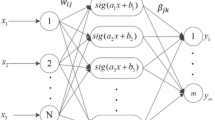Abstract
The transparent open-box (TOB) learning network algorithm adds the useful dimensions to machine learning of auditability and interrogation of each prediction made. It achieves this by making available for instant inspection the exact calculations and relationships it applies to its prediction for each data record in a dataset. The algorithm is applied here to predict the pool boiling heat transfer coefficient (PBHTC) for alumina-water-based nanofluids from a large dataset (870 data records with PBHTC varying from 0.33 to 65.68 kW m−2 K−1). The dataset, compiled from published sources and listed in full in a supplementary file, involves four relatively easy-to-measure input variables (nanoparticle size, operating pressure, nanoparticle concentration in water, and excess temperature). These input variables involve highly fragmented and nonlinear relationships with each other and PBHTC. The TOB predicts PBHTC to high accuracy (TOB: RMSE = 1.27; R2 > 0.99) and its predictions compare favorable to the accuracy achieved by an ANN model applied to the same dataset (ANN: RMSE = 1.09; R2 > 0.9960). The TOB algorithm involves a two-stage routine (Stage 1 matching; Stage 2 optimization) with no overt or underlying correlations involved. It generates dependent-variable predictions with high degrees of accuracy for datasets with irregular, fragmented and nonlinear input variables representing complex chemical and physical systems. Its transparency also provides key insights into the underlying dataset. The TOB algorithm overcomes the black box tendencies of many machine-learning algorithms. This makes the TOB algorithm suitable for deployment in situations where each prediction needs to be verified and supported with the complete step-by-step underlying calculations involved.






Similar content being viewed by others
References
Schmidhuber J. Deep learning in neural networks: an overview. Neural Netw. 2015;61:85–117.
Heinert M. Artificial neural networks–how to open the black boxes. In: Proceedings of application of artificial intelligence in engineering geodesy (AIEG); 2008. p. 42–62.
Wood DA. A transparent open-box learning network provides insight to complex systems and a performance benchmark for more-opaque machine learning algorithms. Adv Geo-Energy Res. 2018;2(2):148–62.
Elkatatny S, Tariq Z, Mahmoud M. Real time prediction of drilling fluid rheological properties using artificial neural networks visible mathematical model (white box). J Pet Sci Eng. 2016;146:1202–10.
Neto AR, Oliveira JL, Passos JC. Heat transfer coefficient and critical heat flux during nucleate pool boiling of water in the presence of nanoparticles of alumina, maghemite and CNTs. Appl Therm Eng. 2017;111:1493–506.
Niu G, Li J. Comparative studies of pool boiling heat transfer with nano-fluids on porous surface. Heat Mass Transf. 2015;51(12):1769–77.
Vafaei S. Nanofluid pool boiling heat transfer phenomenon. Powder Technol. 2015;277:181–92.
Moreno G, Oldenburg SJ, You SM, Kim JH. Pool boiling heat transfer of alumina-water, zinc oxide-water and alumina-water + ethylene glycol nanofluids. In: ASME summer heat transfer conference collocated with the ASME Pacific Rim technical conference and exhibition on integration and packaging of MEMS, NEMS, and electronic systems; 2005. p. 625–32.
You SM, Kim JH, Kim KH. Effect of nanoparticles on critical heat flux of water in pool boiling heat transfer. Appl Phys Lett. 2003;83(16):3374–6.
Kwark SM, Kumar R, Moreno G, Yoo J, You SM. Pool boiling characteristics of low concentration nanofluids. Int J Heat Mass Transf. 2010;53(5–6):972–81.
Manetti LL, Stephen MT, Beck PA, Cardoso EM. Evaluation of the heat transfer enhancement during pool boiling using low concentrations of Al2O3-water based nanofluid. Exp Therm Fluid Sci. 2017;87:191–200.
Kim JH, Kim KH, You SM. Pool boiling heat transfer in saturated nanofluids. In: ASME international mechanical engineering congress and exposition; 2004. p. 621–8.
Shoghl SN, Bahrami M, Jamialahmadi M. The boiling performance of ZnO, α-Al2O3 and MWCNTs/water nanofluids: an experimental study. Exp Therm Fluid Sci. 2017;80:27–39.
Kim SJ, Bang IC, Buongiorno J, Hu LW. Surface wettability change during pool boiling of nanofluids and its effect on critical heat flux. Int J Heat Mass Transf. 2007;50(19–20):4105–16.
Soltani S, Etemad SG, Thibault J. Pool boiling heat transfer performance of Newtonian nanofluids. Heat Mass Transf. 2009;45(12):1555–60.
Wen D, Ding Y. Experimental investigation into the pool boiling heat transfer of aqueous based γ-alumina nanofluids. J Nano Res. 2005;7(2–3):265–74.
Xiao B, Jiang G, Chen L. A fractal study for nucleate pool boiling heat transfer of nanofluids. Sci China Phys Mech Astron. 2010;53(1):30–7.
Shahmoradi Z, Etesami N, Esfahany MN. Pool boiling characteristics of nanofluid on flat plate based on heater surface analysis. Int Commun Heat Mass Transf. 2013;47:113–20.
Cieśliński J, Kaczmarczyk T. The effect of pressure on heat transfer during pool boiling of water-Al2O3 and water-Cu nanofluids on stainless steel smooth tube. Chem Proc Eng. 2011;32(4):321–32.
Bang IC, Chang SH. Boiling heat transfer performance and phenomena of Al2O3–water nano-fluids from a plain surface in a pool. Int J Heat Mass Transf. 2005;48(12):2407–19.
Frontline Solvers. Standard excel solver—limitations of nonlinear optimization. https://www.solver.com/standard-excel-solver-limitations-nonlinear-optimization. Accessed May 2018.
Mitrovic J. Nucleate boiling of refrigerant–oil mixtures: bubble equilibrium and oil enrichment at the interface of a growing vapour bubble. Int J Heat Mass Transf. 1998;41(22):3451–67.
Kharangate CR, Mudawar I. Review of computational studies on boiling and condensation. Int J Heat Mass Transf. 2017;108:1164–96.
Hassanpour M, Vaferi B, Masoumi ME. Estimation of pool boiling heat transfer coefficient of alumina water-based nanofluids by various artificial intelligence (AI) approaches. Appl Therm Eng. 2018;128:1208–22.
Goshayeshi HR, Safaei MR, Goodarzi M, Dahari M. Particle size and type effects on heat transfer enhancement of ferro-nanofluids in a pulsating heat pipe. Powder Technol. 2016;301:1218–26.
Ariana MA, Vaferi B, Karimi G. Prediction of thermal conductivity of alumina water-based nanofluids by artificial neural networks. Powder Technol. 2015;278:1–10.
Das SK, Putra N, Roetzel W. Pool boiling characteristics of nano-fluids. Int J Heat Mass Transf. 2003;46(5):851–62.
Bose NK, Liang P. Neural network fundamentals with graphs, algorithms, and applications. New York: McGraw Hill; 1996.
Author information
Authors and Affiliations
Corresponding author
Electronic supplementary material
Below is the link to the electronic supplementary material.
Rights and permissions
About this article
Cite this article
Wood, D.A., Choubineh, A. & Vaferi, B. Transparent open-box learning network provides auditable predictions. J Therm Anal Calorim 136, 1395–1414 (2019). https://doi.org/10.1007/s10973-018-7722-9
Received:
Accepted:
Published:
Issue Date:
DOI: https://doi.org/10.1007/s10973-018-7722-9




